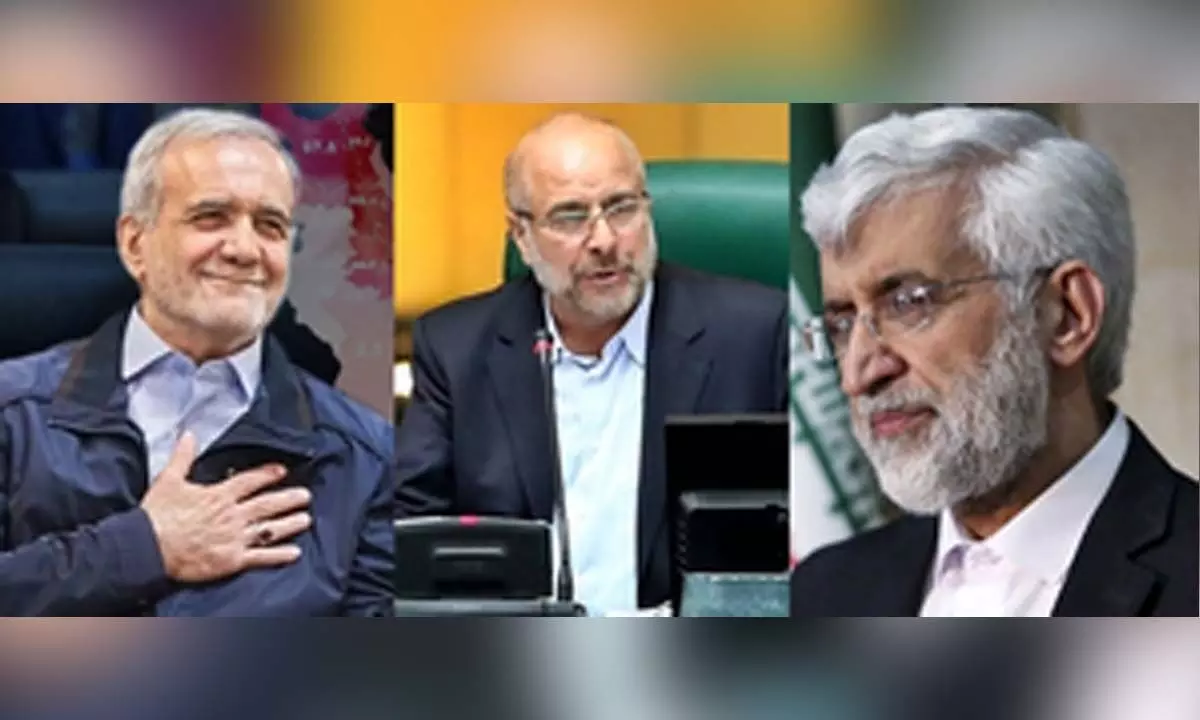Live
- I want to have that chance of playing in IPL, says Swastik Chikara ahead of mega auction
- Damson Technologies Inaugurates State-of-the-Art Manufacturing Facility in Ahmedabad with Rs. 200 Crore planned Investment
- Waqf row: BJP stages protest condemning land grab in Karnataka
- President Droupadi Murmu Graces Koti Deepotsavam in Hyderabad
- South Korean court sentences ex-fiance of Olympic fencing medalist to 13-yr prison term
- Posani Krishna Murali Announces Exit from Politics
- Allu Arjun and Sreeleela to Ignite the Stage with Pushpa-2’s Special Song
- World Television Day 2024: From B&W Beginnings to Smart TVs and Their Role in Shaping Elections
- Bihar: Kaimur residents buy cheap medicines from Jan Aushadhi Kendras, thanks govt
- JMM confident of winning 59 seats in Jharkhand
Just In
Will hardliner-reformist contest in Iran's Presidential poll draw back alienated electorate?

With Iran set to hold snap polls on Friday to elect the successor to late President Ebrahim Raisi, a three-way race -- heading into a run-off -- is likely, as per various surveys, though they differ on the positioning of the top three candidates.
New Delhi: With Iran set to hold snap polls on Friday to elect the successor to late President Ebrahim Raisi, a three-way race -- heading into a run-off -- is likely, as per various surveys, though they differ on the positioning of the top three candidates.
Meanwhile, authorities hope for a heavier 'legitimising' turnout, given the unprecedented low percentage of voting in the 2021 elections and parliamentary polls earlier this year.
The turnout in the 2021 elections - which Raisi won - was 48.8 per cent - the lowest ever so far since the 1979 revolution. It further declined to around 41 per cent in the two-round Majles election in March and May this year. Part of the disenchantment of voters is over social and economic issues and the prevention of a large number of reformists. Mavericks like former President Mahmoud Ahmadinejad, barred from the presidential race, also do not pass vetting.
The predictions of the likely turnout, as per the surveys and analyses, depend on the orientation of the pollsters or analysts. While those by emigres, who do not enjoy the best of relations with the present Iranian dispensation, claim a much lower turnout would be recorded this time, those by in-country groups, related to government institutions, are more sanguine, report a slight bump up.
However, they also do not predict any radical breakout.
It was perhaps with this in mind, that Supreme Leader Ayatollah Ali Khamenei on Tuesday called for a "maximum" voter turnout in a message to the country's "enemies".
"The Islamic Republic has enemies. One thing that helps the Islamic Republic overcome its enemies is the elections. If a good turnout is seen in these elections, then it will make the Islamic Republic proud," he said in his address at a religious function.
A day before the election, five of the six approved candidates, pegged as four hardliners/conservatives, of various intensities, and reformist, were in the race. Like previous some pervious instances, one of the hardline candidates -- Vice President and Foundation of Martyrs and Veteran Affairs head Amir-Hossein Ghazizadeh Hashemi -- dropping out and urging others to do so to coalesce support between one strong (hardline) candidate.
However, Hashemi, whose withdrawal was announced on the eve of polls, did not indicate any choice of candidate.
The other two -- Tehran Mayor Ali Alireza Zakani and celeriac and former Minister Mostafa Pourmohammadi -- do not figure much in the calculus.
However, the surveys rate the chances of the top three quite differently, as per reports.
The Iranian Students Polling Agency (ISPA), which is affiliated with the government's Academic Centre of Education, Research, and Culture, in a survey published on Wednesday last week, has forecast a turnout of over 50 per cent, placing Jalili first, and Pezeshkian second - less than a percentage point ahead of Qalibaf.
However, its update on Monday had Pezeshkian now leading over Jalili, albeit by a small margin, while Qalibaf stayed in third place.
In both, none of the leading candidates was even the 30 per cent mark, indicating a run-off.
Meta, a polling organisation in the Imam Sadeq University in Tehran, in its survey published last week, had forecast just over 50 per cent turnout, with Pezeshkian ahead - but over Qalibaf, while Jalili was in third place.
An update this week had the same positioning but with lower numbers for the candidates. It was also claimed that in a run-off, Qalibaf would beat Pezeshkian, and if the run-off was Qalibaf vs Jalili, the former would triumph then too.
A survey by the "privately-run" Shenaakht, coming out in the middle of the month, predicted well over 50 per cent turnout, and Qalibaf on top and both Pezeshkian and Jalili tied in second place - over 10 percentage points behind.
While for Jalili and Qalibaf, their closeness to Supreme Leader Khamenei and the IRGC background could weigh in their favour with their establishment, sole reformist candidate Pezeshkian, whose presence seems geared at drawing out reformist voters for higher voting, may find the going tough unless there is a massive turnout in his favour.
However, his ethnic background - being an Azeri - could cloud his chances. And then, his recent statements supporting Iran's return to the nuclear deal and wider outreach to the West drew veiled censure from the Supreme Leader, who was scornful of those believing that "everything good comes from the US". The other two peg more hopes from BRICS and the SCO.
Pezeshkian also strayed from consensus by expressing support for Ukraine in its conflict with Russia.
But, no matter who wins, any radical change in domestic and foreign policies is unlikely since the President is only the second in command. And then, it is the Supreme Leader who also certifies the winner.

© 2024 Hyderabad Media House Limited/The Hans India. All rights reserved. Powered by hocalwire.com






